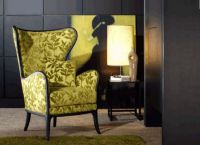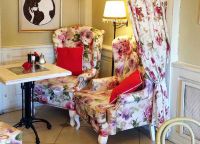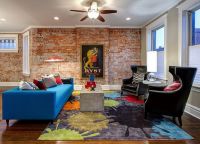This truly English chair in his homeland is called Wingback Chair, but it is customary to call these protruding details with ears. In general, the chair of this design has been more than 300 years, so it has managed to change a lot of names. It was most popular during the time of Voltaire, so you can often hear what it is called “Voltaire.” Well, if it’s easier, then “grandfather”, “fireplace” or simply “English”.
No matter how he was “called”, his features remain unchanged, namely:
- He has low wooden curved legs;
- deep seat;
- high back;
- Wings (ears, cheeks) on the sides of the back, smoothly turning into armrests.
The dimensions and shape of the ears themselves can be any – large, medium, small, curly, straight, like wings of a butterfly or bat.
The upholstery of the chair with the “ears” can be smooth, vile, quilted. The armrests are soft or wooden. The back is straight or rounded. In general, there are no strict rules for its execution. The main thing is the presence of ears. It is they who make him recognizable in any interpretation.
Chairs with “ears” in the interior
The English chair with “ears” in modern houses and apartments can complement such styles as classic, the style of minimalism, Baroque and Rococo. In addition, with their help you can create mixed interiors in which mixed furniture sets are combined.
The fireplace with “ears” looks equally good when decorating a dining room and dining area, in living rooms and trimming zones, in the office and the home library.
A high armchair with “ears” and a deep seat makes the process of work, reading, rest, meals as comfortable as possible. And it looks expensive and respectable in any interior, adding a special comfort and warmth to the situation.

|

|

|

|

|

|

|

|

|
